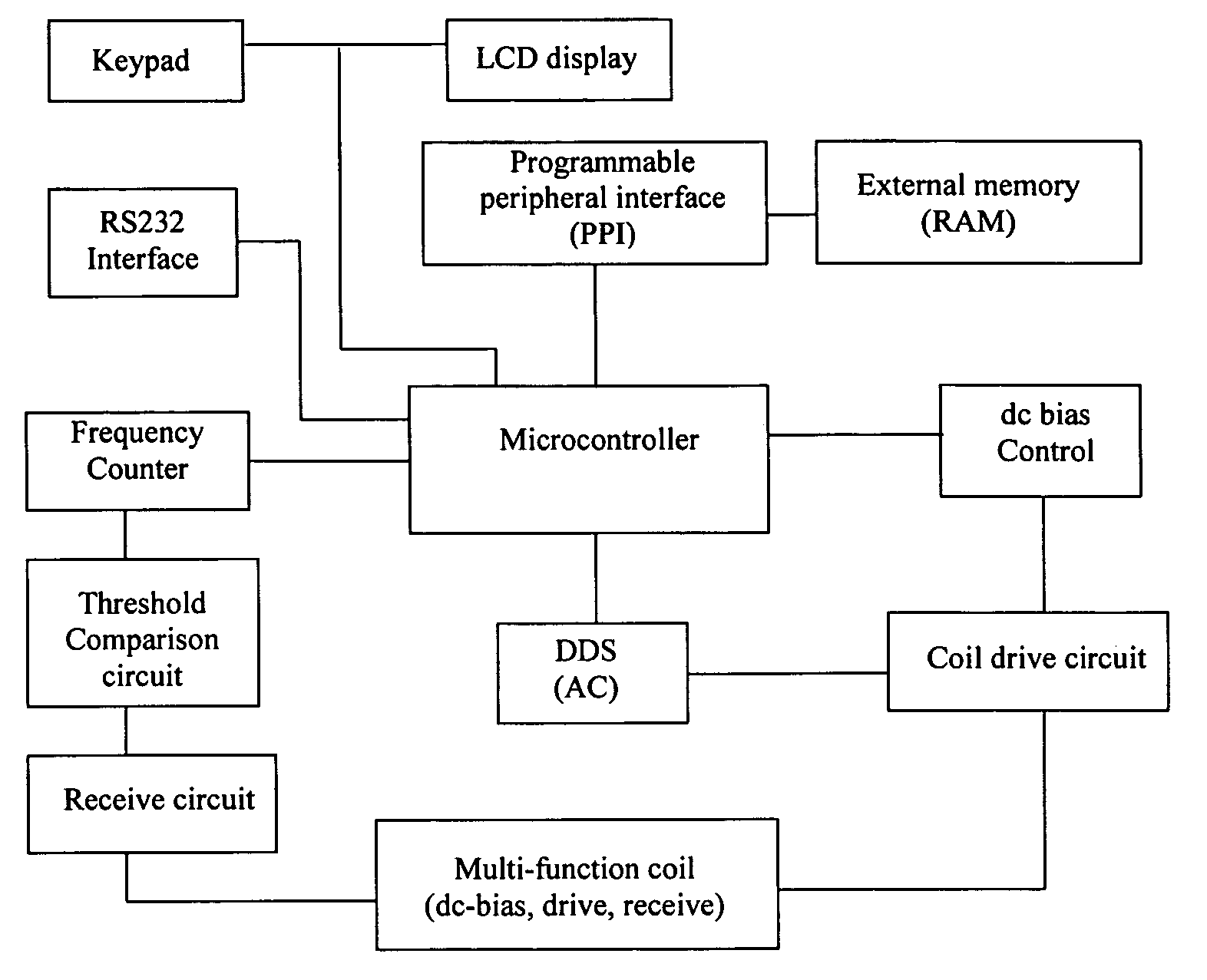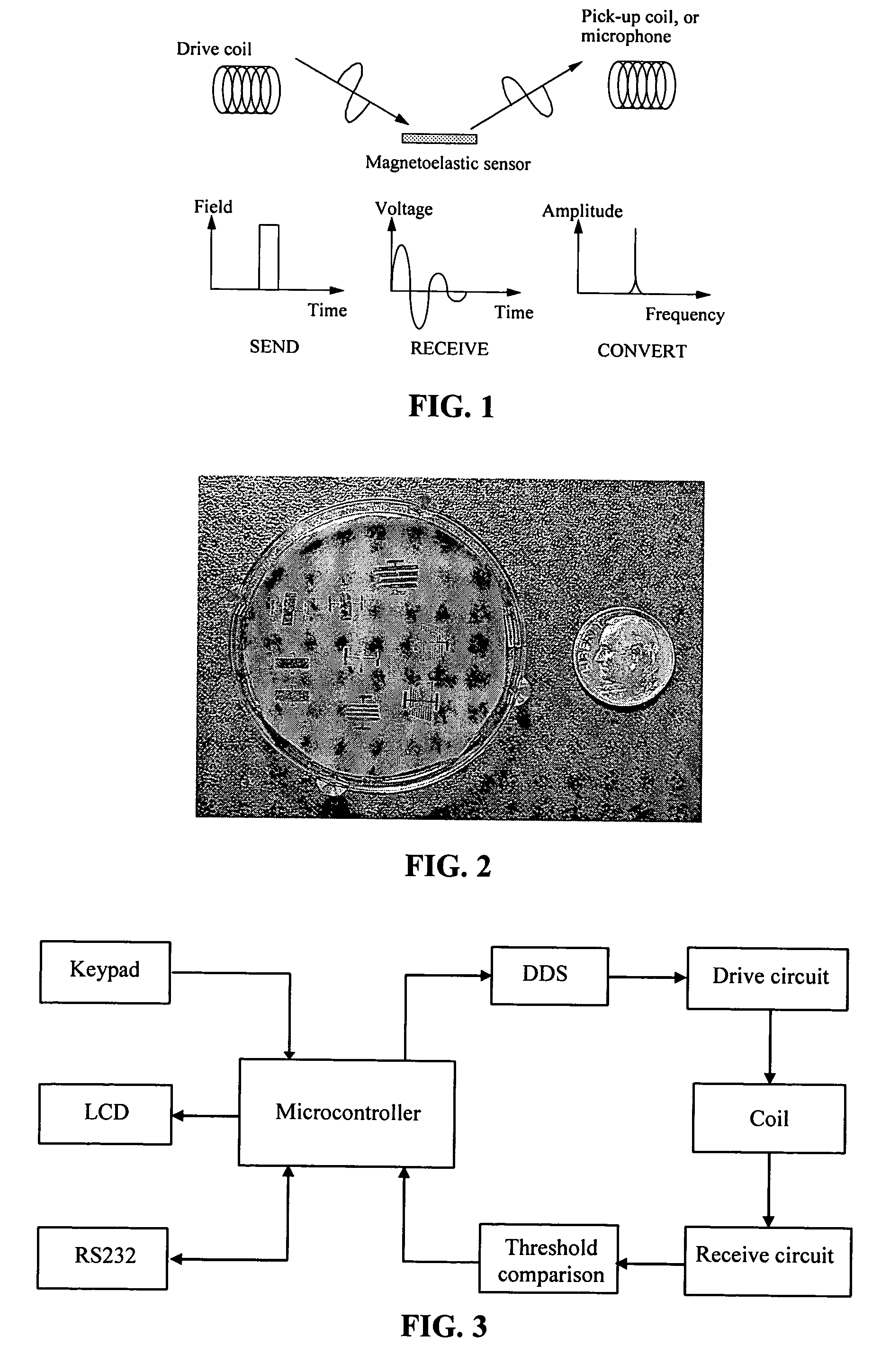Technique and electronic circuitry for quantifying a transient signal using threshold-crossing counting to track signal amplitude
a technology of transient signal and counting, applied in the direction of noise figure or signal-to-noise ratio measurement, instruments, specific gravity measurement, etc., can solve the problem of severe limitation of the practical application of resonator-type sensor units in real-world operation
- Summary
- Abstract
- Description
- Claims
- Application Information
AI Technical Summary
Benefits of technology
Problems solved by technology
Method used
Image
Examples
examples of embodiments
OF THE INVENTION
[0117]By way of example only, two sensing systems are described, next. Example System 1 employs a high-speed DS87C520 microcontroller that can directly perform the frequency counting operation (no need for external counter units). Example System 2 uses a lower-cost AT89S53 microcontroller, an external counter(s) to precisely count the time for the frequency counting operation, and features software-controlled dc biasing field and thresholds. Along with a microcontroller (such as that depicted in FIGS. 3, 4), the following are employed: a threshold comparison circuit (e.g., FIGS. 7, 11) for signal conversion, an interrogation circuit that consists of a drive amplifier (e.g., FIG. 9), an instrumentation amplifier (e.g., FIG. 10), and a multifunctional interrogation coil (e.g., FIG. 8). The circuitry can be packaged into a compact plastic container, or other suitable material, along with a receiver-element such as a solenoid coil. For sensor interrogation, a ‘ring-and-l...
example 1
[0118]The microcontroller used in the design is a DS87C520 from Dallas Semiconductor Corporation. The DS87C520 microcontroller belongs to the 8051 family having the following characteristics: speed is up to 33 MHz crystal frequency, on-chip memory is 16 KB of ROM and 1 KB of MOVX RAM, has three internal 16-bit timers (labeled Timer 0–2) that are used in combination (FIGS. 7, 11, 14) to electronically implement the threshold-crossing counting technique for frequency measurement, damping measurement, and amplitude-frequency spectrum analysis according to the invention.
[0119]Direct digital synthesis (DDS) is a technique that is used to generate a frequency-agile, highly pure sine wave, or any arbitrary waveforms, from an accurate reference clock. The frequency of the output is digitally controlled by an N-bit digital word that allows sub-Hz frequency agility. The output waveform is normally reconstructed with a high-speed digital to analog converter (DAC). The magnetoelastic sensor sys...
example 2
[0123]Core functionalities for the Example System 2 are the same as for Example System 1, plus the dc biasing field and the threshold voltages in the comparator circuit can be adjusted via software. This permits the system to monitor sensor elements of different sizes and shapes, where different biasing fields and thresholds are used, without requiring the change-out of circuitry components. Example System 2 uses a lower-cost microcontroller than that of Example System 1. The microcontroller unit AT89S53 distributed by Atmel of Example System 2 has similar features and performance, to that of the DS87C520, but the timer / counters speed is slower. If microcontroller speed is insufficient to perform certain of the counting / timing function(s), counter(s) that are external to the microcontroller are used. To perform a frequency counting operation, the timer / counters of the microcontroller have to track the number of cycles of the sensor transient signal, as well as the elapsed time durin...
PUM
| Property | Measurement | Unit |
|---|---|---|
| threshold voltage | aaaaa | aaaaa |
| resonance frequency | aaaaa | aaaaa |
| length | aaaaa | aaaaa |
Abstract
Description
Claims
Application Information
 Login to View More
Login to View More - R&D
- Intellectual Property
- Life Sciences
- Materials
- Tech Scout
- Unparalleled Data Quality
- Higher Quality Content
- 60% Fewer Hallucinations
Browse by: Latest US Patents, China's latest patents, Technical Efficacy Thesaurus, Application Domain, Technology Topic, Popular Technical Reports.
© 2025 PatSnap. All rights reserved.Legal|Privacy policy|Modern Slavery Act Transparency Statement|Sitemap|About US| Contact US: help@patsnap.com



